How To Treat Subflooring For Pet Odor And Stains Before Installing New Flooring
Pets that aren't properly house trained tend to choose the same spot over and over again to do their business, and that gives the smelly urine a chance to seep through the floor covering — even if it's wood — and into the subfloor. Once this happens, the only way to get rid of the smell is to remove and replace the floor covering and treat the subfloor.
Urine in a plywood subfloor or a concrete one can usually be neutralized, and if you seal the affected area before installing new flooring, that should be the end of your odor problem. Particleboard is a different matter. It soaks up the urine so efficiently that eliminating all the odor-causing crystals is virtually impossible, so you usually have to replace the affected part of a particleboard subfloor.
Treating Urine in a Plywood Subfloor
After you've removed the floor covering, you want to make sure to identify the entire stained area. The most strongly affected areas will be discolored, but if you shine a black light on the surrounding plywood, you'll probably detect the telltale florescent shine of uric acid in other places. Mark all such places for treatment and use the following protocol for best results:
- Apply an enzymatic pet odor remover. You can choose one of several products, including Nature's Miracle, Anti-Icky-Poo or Zero Odor. Some products work better for cat urine than dog urine, and vice versa, so read the label to make sure you get the right product.
- Allow the cleaner at least 24 hours to soak into the wood. It's a good idea to cover the treated area with plastic to control evaporation.
- Let the wood dry out completely. It's best to wait for an extra 24 to 48 hours after you remove the plastic.
- Apply a subfloor sealer. The best floor sealer for pet urine is a stain-blocking primer, such as Kilz 3 Premium Interior/Exterior primer, which not only blocks stains and odors but also contains a mildewcide. Any all-purpose oil- or water-based stain-blocking primer will work, especially if you apply two or three coats.
Neutralizing Pet Urine With Household Products
Enzymatic cleaners work best for neutralizing pet urine, but some household cleaners also work, especially if the urine problem isn't severe. Here are some possibilities:
- A 2-to-1 mixture of warm water and white vinegar**.** Spray this over the affected area, or spread it with a brush, and let it soak in. Blot dry after a few minutes.
- A 3 percent hydrogen peroxide solution**.** Spray it on, let it sit for a few minutes and blot dry.
- Peroxide, dish soap and baking soda. Mix about 14 ounces of 3-percent peroxide with a dash of dish soap and add about 1/2 teaspoon of baking soda. Spray on and blot dry after a few minutes.
Avoid using any product that contains ammonia because it smells so much like urine that it will just compound the odor problem. It's also a good idea to avoid cleaning the subfloor with bleach. Its high surface tension prevents it from soaking into the wood, so it won't eliminate the odor completely.
Treating an Unsealed Concrete Subfloor
The porosity of concrete compounds the difficulty of removing urine odors, so an enzymatic odor remover is a necessity. Spray the cleaner or spread it over the affected area with a scrub brush, using a generous amount to ensure it soaks in. Cover the treated area with plastic to prevent evaporation and wait for 24 hours before removing the plastic and letting the area dry out.
Seal the subfloor with two coats of a high-quality acrylic or polyurethane subfloor sealer. Allow the sealer to cure for a day or two before installing the floor covering.
